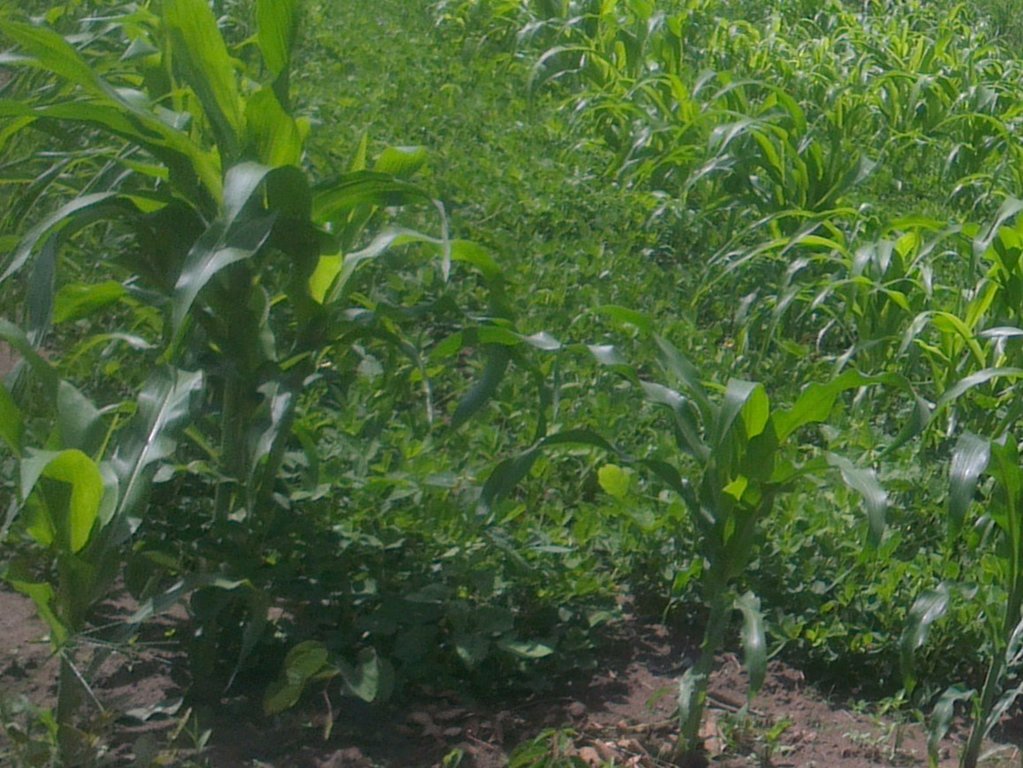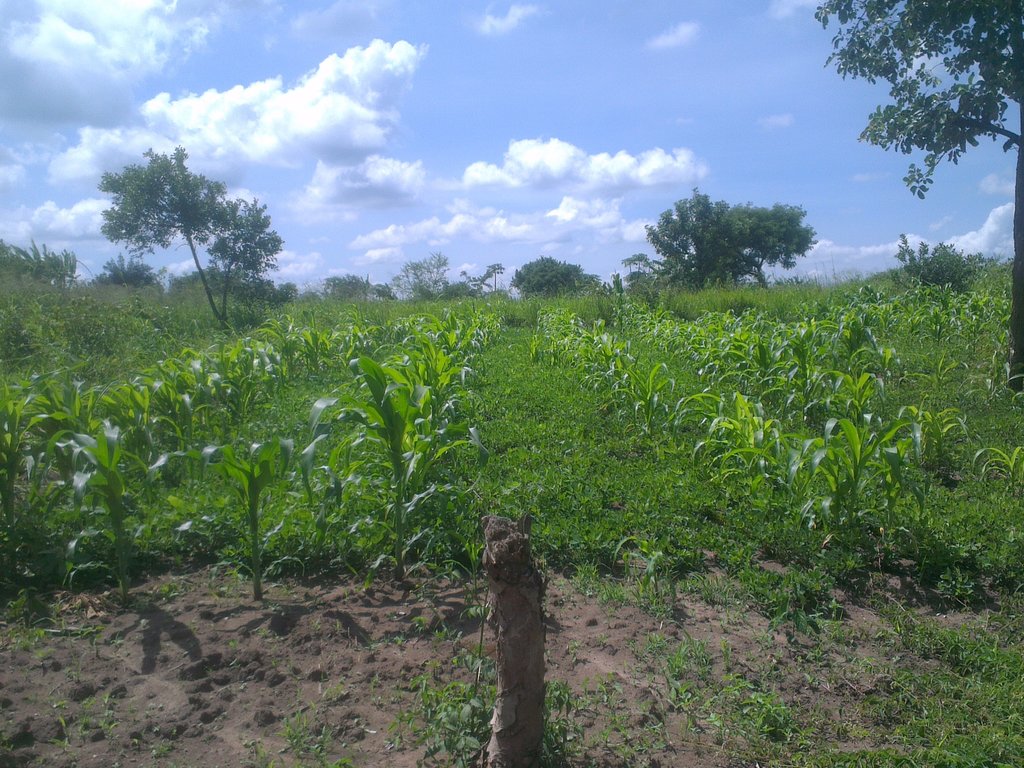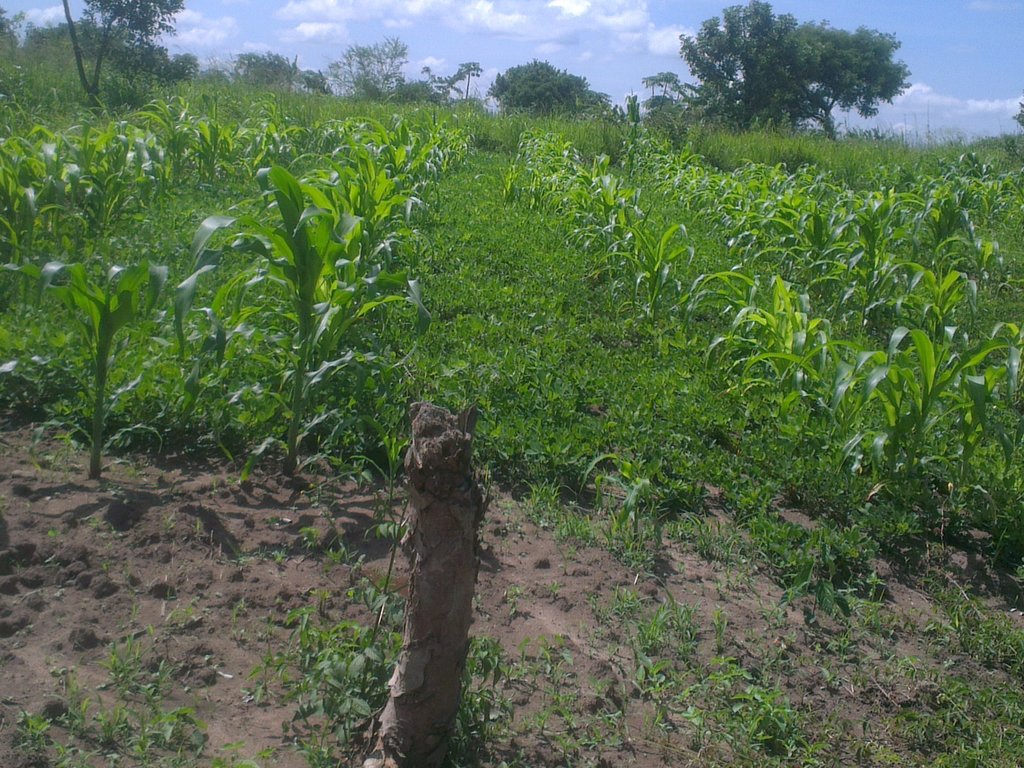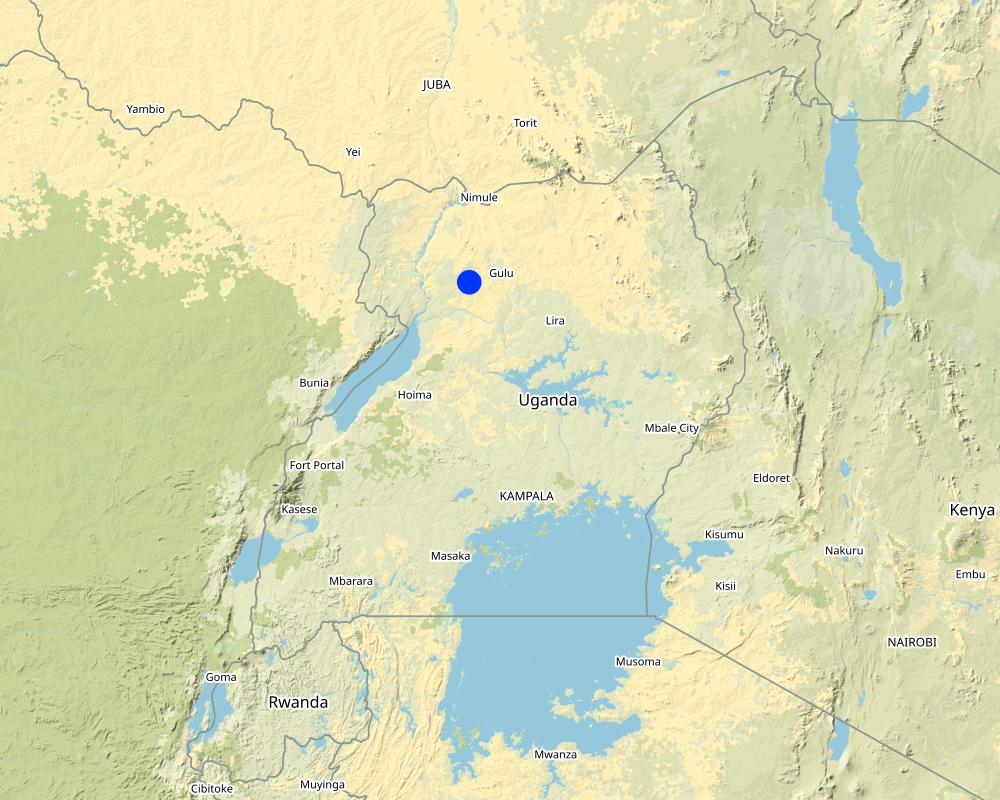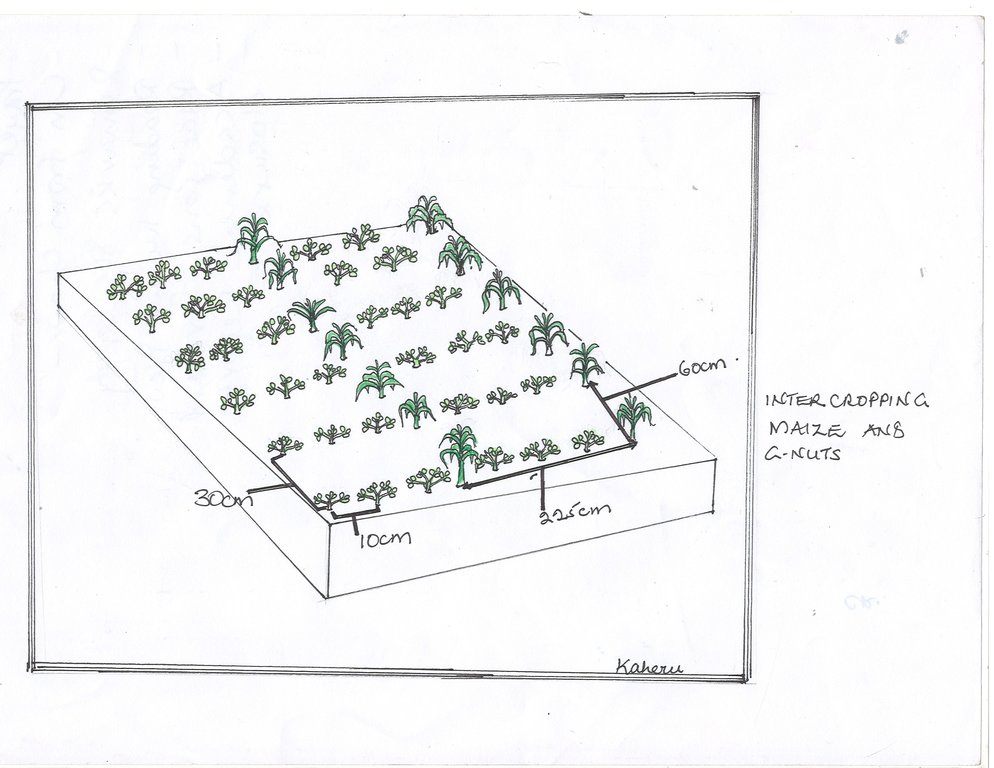Intercropping Maize and Ground Nuts for Optimum Land Utilisation, Increased Food Production, Household Income and Food Security [Uganda]
- Criação:
- Atualização:
- Compilador/a: Jalia Namakula
- Editor: Kamugisha Rick Nelson
- Revisores: Udo Höggel, John Stephen Tenywa, Nicole Harari, Joana Eichenberger
Rub Kodi
technologies_2929 - Uganda
- Resumo completo em PDF
- Resumo completo em PDF para impressão
- Resumo completo no navegador
- Resumo completo (sem formatação)
- Intercropping Maize and Ground Nuts for Optimum Land Utilisation, Increased Food Production, Household Income and Food Security: 18 de Agosto de 2022 (inactive)
- Intercropping Maize and Ground Nuts for Optimum Land Utilisation, Increased Food Production, Household Income and Food Security: 18 de Novembro de 2022 (public)
Veja as seções
Expandir tudo Recolher tudo1. Informação geral
1.2 Detalhes do contato das pessoas capacitadas e instituições envolvidas na avaliação e documentação da tecnologia
Pessoa(s) capacitada(s)
usuário de terra:
Ocen Francis
Riber Farmers Group
Uganda
Nome do projeto que facilitou a documentação/avaliação da Tecnologia (se relevante)
Scaling-up SLM practices by smallholder farmers (IFAD)Nome da(s) instituição(ões) que facilitou(ram) a documentação/ avaliação da Tecnologia (se relevante)
CDE Centre for Development and Environment (CDE Centre for Development and Environment) - Suíça1.3 Condições em relação ao uso da informação documentada através de WOCAT
O/a compilador/a e a(s) pessoa(s) capacitada(s) aceitam as condições relativas ao uso de dados documentados através da WOCAT:
Sim
1.4 Declaração de sustentabilidade da tecnologia descrita
A tecnologia descrita aqui é problemática em relação a degradação da terra de forma que não pode ser declarada uma tecnologia de gestão sustentável de terra?
Não
Comentários:
Inter cropping cereal and legume based systems aims at maximizing the production potential per unit area .
2. Descrição da tecnologia de GST
2.1 Descrição curta da tecnologia
Definição da tecnologia:
Improved maize (zea mays)-groundnuts (arachis hypogaea) optimum intercropping pattern is a technology promoted by IITA (International Institute for Tropical Agriculture) among small scale farmers through demonstrations /trials. It is promoted for improving food and income security and optimum land utilisation.
2.2 Descrição detalhada da tecnologia
Descrição:
The International Institute of Tropical Agriculture (IITA) has been promoting smart intercropping patterns in Nwoya District, Northern Uganda. The inter crops promoted are based on maize-legume sustainable intensification farming systems with focus on conservation farming as a technology. This technology is promoted because it reduces management inputs costs such as labour for weeding and application of fertilizers which results into sustainable systems and if efficiently used to potentially replenish natural resources.The demonstration/ trial is located in Alero Sub County, Nwoya District, which on average receives 1200 mm of rainfall annually established on a reddish soil with relatively low soil organic matter on a plot size of 180 m2 planted with groundnuts as the major crop spaced at 30cm×10cm and maize intercrop at a spacing of 225 cm×60cm, such that within every 5 lines of groundnuts one line of maize is planted.
The groundnuts (local red variety called red beauty) are locally obtained from the nearby local market, while the maize is an open pollinated variety (Longe 5) bought from the local agro input dealer. The inter crop was planted to increase productivity and reduce the risk of total crop failure.
Prior to establishment, Riber farmers group selected a site close to the road to act as there demo/plot.The plot was slashed, sprayed with glyphosate and then marked using 60-cm pegs to get the correct spacing and proper plant population. Ground nuts were planted first then the maize planted a fortnight later using the following inputs 3 kg of maize bought at UGX 1500, 15 kg of groundnuts bought at UGX 5000 and 1 litre of liquid fertiliser at UGX 15000 and 1 litre of glyphosate bought at UGX 20,000.
Inter cropping is majorly preferred by farmers because it enhances maximum utilization of land, reduces risk of total crop failure, and increases income and food security. It also acts as a means of weed management. In some inter cropping systems, the legumes act as soil cover and fix atmospheric nitrogen in the soil, and promote product diversity for food security and income generation.
However weeding an inter crops is challenging compared to weeding a pure stand and encourages competition for resources such as soil nutrients, moisture and light, which may affect crop productivity. Its therefore recommend that the farmer keep in touch with the extension worker for advisory services ( proper management, pests and diseases management)
2.3 Fotos da tecnologia
2.4 Vídeos da tecnologia
Data:
28/04/2017
Localização:
Alero sub-county Nwoya District
Nome do cinegrafista:
Jalia Namakula
2.5 País/região/locais onde a tecnologia foi aplicada e que estão cobertos nesta avaliação
País:
Uganda
Região/Estado/Província:
Northern Uganda
Especificação adicional de localização:
Bwobo nam, Alero Sub-county,Nwoya District
Especifique a difusão da tecnologia:
- Uniformemente difundida numa área
Se a área precisa não for conhecida, indicar a área aproximada coberta:
- < 0,1 km2 (10 ha)
Map
×2.6 Data da implementação
Indique o ano de implementação:
2016
Caso o ano exato seja desconhecido, indique a data aproximada:
- menos de 10 anos atrás (recentemente)
2.7 Introdução da tecnologia
Especifique como a tecnologia foi introduzida:
- através de projetos/intervenções externas
Comentários (tipos de projeto, etc.):
The intercropping pattern was introduced by International Institute for Tropical Agriculture (IITA)
3. Classificação da tecnologia de GST
3.1 Principal/principais finalidade(s) da tecnologia
- Melhora a produção
- Criar impacto econômico benéfico
3.2 Tipo(s) atualizado(s) de uso da terra onde a tecnologia foi aplicada

Terra de cultivo
- Cultura anual
Número de estações de cultivo por ano:
- 2
Especifique:
The intercrop is done twice annually but the legumes change every season, sometimes soybean is planted instead of groundnuts (March-August and September-December)
Comentários:
The demonstration site is located by the road side. It is surrounded by bush fallows and a small banana plantation (musa spp)
3.4 Abastecimento de água
Abastecimento de água para a terra na qual a tecnologia é aplicada:
- Precipitação natural
Comentários:
The group depends on rain fall for growing crops on this plot.
3.5 Grupo de GST ao qual pertence a tecnologia
- Gestão integrada de fertilidade do solo
- variedades vegetal/raças de animais melhoradas
3.6 Medidas de GST contendo a tecnologia

Medidas agronômicas
- A1: cobertura vegetal/do solo
- A2: Matéria orgânica/fertilidade do solo
- A5: Gestão de sementes, variedades melhoradas
Comentários:
The groundnuts act as a soil cover and also fix nitrogen in the soil improving soil fertility
3.7 Principais tipos de degradação da terra abordados pela tecnologia

Erosão do solo pela água
- Wt: Perda do solo superficial/erosão de superfície

Deteriorização química do solo
- Cn: declínio de fertilidade e teor reduzido de matéria orgânica (não causado pela erosão)

Degradação biológica
- Bl: perda da vida do solo
Comentários:
The demo plot was established on an intensely cultivated area, the legumes are planted to improved soil fertility . in addition the groundnuts act as a soil cover therefore reducing soil erosion.
3.8 Redução, prevenção ou recuperação da degradação do solo
Especifique o objetivo da tecnologia em relação a degradação da terra:
- Prevenir degradação do solo
Comentários:
The ground nuts are inter cropped to not only increase crop diversity on the plot but to also reduce soil erosion incidence.
4. Especificações técnicas, implementação de atividades, entradas e custos
4.1 Desenho técnico da tecnologia
4.2 Informação geral em relação ao cálculo de entradas e custos
Especifique como custos e entradas foram calculados:
- por área de tecnologia
Indique o tamanho e a unidade de área:
180m2
Se utilizar uma unidade de área local, indicar fator de conversão para um hectare (por exemplo, 1 ha = 2,47 acres): 1 ha =:
0.018 ha
Outro/moeda nacional (especifique):
UGX
Se for relevante, indique a taxa de câmbio do USD para moeda local (por exemplo, 1 USD = 79,9 Real): 1 USD =:
3680,0
Indique a média salarial da mão-de-obra contratada por dia:
3000/=
4.3 Atividades de implantação
| Atividade | Periodicidade (estação do ano) | |
|---|---|---|
| 1. | Bush clearing | January |
| 2. | Slashing and spraying | January |
| 3. | Field marking | January |
| 4. | Planting both maize and beans | March |
4.4 Custos e entradas necessárias para a implantação
| Especifique a entrada | Unidade | Quantidade | Custos por unidade | Custos totais por entrada | % dos custos arcados pelos usuários da terra | |
|---|---|---|---|---|---|---|
| Mão-de-obra | Slashing | People | 15,0 | 3000,0 | 45000,0 | 100,0 |
| Mão-de-obra | Ploughing | People | 15,0 | 3000,0 | 45000,0 | 100,0 |
| Mão-de-obra | Field Marking | People | 15,0 | 3000,0 | 45000,0 | 100,0 |
| Mão-de-obra | Planting | People | 15,0 | 3000,0 | 45000,0 | 100,0 |
| Equipamento | Strings | Piece | 1,0 | 8000,0 | 8000,0 | 100,0 |
| Equipamento | Planting Pegs | bundle | 2,0 | 5000,0 | 10000,0 | 100,0 |
| Equipamento | Tape Measure | Piece | 1,0 | 25000,0 | 25000,0 | 100,0 |
| Material vegetal | Groundnuts | kg | 15,0 | 2500,0 | 37500,0 | 100,0 |
| Material vegetal | Longe5 (maize) | kg | 3,0 | 1500,0 | 4500,0 | 100,0 |
| Fertilizantes e biocidas | Liquid fertiliser (DI grow) | Ltr | 1,0 | 15000,0 | 15000,0 | 100,0 |
| Custos totais para a implantação da tecnologia | 280000,0 | |||||
Comentários:
IITA introduced the technology to the farmers group however establishment and maintenance costs were incurred by the group
4.5 Atividades recorrentes/manutenção
| Atividade | Periodicidade/frequência | |
|---|---|---|
| 1. | Weeding | April |
| 2. | Spraying | fort night |
Comentários:
Weeding is done once because the ground nuts close the canopy therefore inhibiting weeds growth.
4.6 Custos e entradas necessárias pata a manutenção/atividades recorrentes (por ano)
| Especifique a entrada | Unidade | Quantidade | Custos por unidade | Custos totais por entrada | % dos custos arcados pelos usuários da terra | |
|---|---|---|---|---|---|---|
| Mão-de-obra | Weeding | people | 15,0 | 3000,0 | 45000,0 | 100,0 |
| Mão-de-obra | spraying | people | 1,0 | 3000,0 | 3000,0 | 100,0 |
| Equipamento | knapsacks sprayer | Piece | 1,0 | 55000,0 | 55000,0 | 100,0 |
| Custos totais para a manutenção da tecnologia | 103000,0 | |||||
Se o usuário da terra arca com menos que 100% dos custos, indique quem cobre os custos remanescentes:
The group incurred all the costs
4.7 Fatores mais importantes que afetam os custos
Descreva os fatores mais determinantes que afetam os custos:
Labour is the most important factor affecting costs.
5. Ambiente natural e humano
5.1 Clima
Precipitação pluviométrica anual
- <250 mm
- 251-500 mm
- 501-750 mm
- 751-1.000 mm
- 1.001-1.500 mm
- 1.501-2.000 mm
- 2.001-3.000 mm
- 3.001-4.000 mm
- > 4.000 mm
Especifique a média pluviométrica anual em mm (se conhecida):
1100,00
Especificações/comentários sobre a pluviosidade:
The first season starts in March-June , season 2016A and B the rains have not been sufficient, the second season starts in September -November and the dry spell begins in December - March
Zona agroclimática
- úmido
5.2 Topografia
Declividade média:
- Plano (0-2%)
- Suave ondulado (3-5%)
- Ondulado (6-10%)
- Moderadamente ondulado (11-15%)
- Forte ondulado (16-30%)
- Montanhoso (31-60%)
- Escarpado (>60%)
Formas de relevo:
- Planalto/planície
- Cumes
- Encosta de serra
- Encosta de morro
- Sopés
- Fundos de vale
Zona de altitude:
- 0-100 m s.n.m.
- 101-500 m s.n.m.
- 501-1.000 m s.n.m.
- 1.001-1.500 m s.n.m.
- 1.501-2.000 m s.n.m.
- 2.001-2.500 m s.n.m.
- 2.501-3.000 m s.n.m.
- 3.001-4.000 m s.n.m.
- > 4.000 m s.n.m.
Indique se a tecnologia é aplicada especificamente em:
- Não relevante
5.3 Solos
Profundidade do solo em média:
- Muito raso (0-20 cm)
- Raso (21-50 cm)
- Moderadamente profundo (51-80 cm)
- Profundo (81-120 cm)
- Muito profundo (>120 cm)
Textura do solo (solo superficial):
- Médio (limoso, siltoso)
Textura do solo (>20 cm abaixo da superfície):
- Fino/pesado (argila)
Matéria orgânica do solo superficial:
- Médio (1-3%)
5.4 Disponibilidade e qualidade de água
Lençol freático:
5-50 m
Disponibilidade de água de superfície:
Precário/nenhum
Qualidade da água (não tratada):
Água potável boa
A salinidade da água é um problema?
Não
Ocorre inundação da área?
Não
Comentários e outras especificações sobre a qualidade e a quantidade da água:
The water is drawn from the borehole and considered of good quality and is readily available
5.5 Biodiversidade
Diversidade de espécies:
- Médio
Diversidade de habitat:
- Médio
5.6 Características dos usuários da terra que utilizam a tecnologia
Sedentário ou nômade:
- Sedentário
Orientação de mercado do sistema de produção:
- misto (subsistência/comercial)
Rendimento não agrícola:
- Menos de 10% de toda renda
Nível relativo de riqueza:
- Pobre
Indivíduos ou grupos:
- Grupos/comunidade
Nível de mecanização:
- Trabalho manual
Gênero:
- Mulheres
- Homens
Idade dos usuários da terra:
- meia-idade
Indique outras características relevantes dos usuários da terra:
They are a farmer's group with a membership of 35(20Males and 15Females) they are all small scale farmers
5.7 Área média de terrenos utilizados pelos usuários de terrenos que aplicam a Tecnologia
- < 0,5 ha
- 0,5-1 ha
- 1-2 ha
- 2-5 ha
- 5-15 ha
- 15-50 ha
- 50-100 ha
- 100-500 ha
- 500-1.000 ha
- 1.000-10.000 ha
- > 10.000 ha
É considerado pequena, média ou grande escala (referente ao contexto local)?
- Pequena escala
Comentários:
general land sizes owned by members is 2 acres
5.8 Propriedade de terra, direitos de uso da terra e de uso da água
- Customary
- Customary
Direitos do uso da água:
- Comunitário (organizado)
Comentários:
The land is owned by the clan and is passed on to family members
5.9 Acesso a serviços e infraestrutura
Saúde:
- Pobre
- Moderado
- Bom
Educação:
- Pobre
- Moderado
- Bom
Assistência técnica:
- Pobre
- Moderado
- Bom
Emprego (p. ex. não agrícola):
- Pobre
- Moderado
- Bom
Mercados:
- Pobre
- Moderado
- Bom
Energia:
- Pobre
- Moderado
- Bom
Vias e transporte:
- Pobre
- Moderado
- Bom
Água potável e saneamento:
- Pobre
- Moderado
- Bom
Serviços financeiros:
- Pobre
- Moderado
- Bom
6. Impactos e declarações finais
6.1 Impactos no local mostrados pela tecnologia
Impactos ecológicos
Solo
Cobertura do solo
Comentários/especificar:
They act as a soil cover
6.4 Análise do custo-benefício
Como os benefícios se comparam aos custos de implantação (do ponto de vista dos usuários da terra)?
Retornos a curto prazo:
levemente positivo
Retornos a longo prazo:
levemente positivo
Como os benefícios se comparam aos custos recorrentes/de manutenção(do ponto de vista dos usuários da terra)?
Retornos a curto prazo:
positivo
Retornos a longo prazo:
positivo
Comentários:
The intercrops are an annual enterprise therefore benefts are realised in the short term. the group indicated that they planted one(1) kg of maize seed the previous season and got 200kgs after harvesting. however in this particular season the harvests were not yet made
6.5 Adoção da tecnologia
- 11-50%
Se disponível, determine a quantidade (número de unidades familiares e/ou área abordada):
The group has a membership of 35 people all the group members have transffered the technology into their own farms.
De todos aqueles que adotaram a Tecnologia, quantos o fizeram espontaneamente, ou seja, sem receber nenhum incentivo/ pagamento material?
- 51-90%
Comentários:
All the members received seed from the proceeds of the previous season from the group demo and were supposed to transfer the technology to their different individual farms.
6.6 Adaptação
A tecnologia foi recentemente modificada para adaptar-se as condições variáveis?
Não
6.7 Pontos fortes/vantagens/oportunidades da tecnologia
| Pontos fortes/vantagens/oportunidades na visão do usuário da terra |
|---|
| The technology is good at Improving crop yield due to the crop, nutrients, fertility |
| Inter cropping leads to weed suppression |
| The technology controls pest and disease incidence. |
| Pontos fortes/vantagens/oportunidades na visão do/a compilador/a ou de outra pessoa capacitada |
|---|
| Legumes act as soil cover hence reduction in soil moisture |
| Reduces risk of total crop failure. In case the drought starts early the farmer would have already harvested the legumes. |
| Improve soil fertility resulting from the legumes fixing nitrogen in the soils |
6.8 Pontos fracos, desvantagens/riscos da tecnologia e formas de superá-los
| Pontos fracos/desvantagens/riscos na visão do usuário da terra | Como eles podem ser superados? |
|---|---|
| Weeding in intercrops is cumbersome | weed when crops are still young |
| It is not easy to use chemical weed control in intercrops | This is overcome by spraying weeds before planting hence reducing on their vigour and also weeding early |
| sometimes the right plant population is not got reducing on the crop yields of intercrops | This is overcome by marking the correct spacing of the major crop to atleast get optimum plant population for the major crop |
| Pontos fracos/vantagens/riscos na visão do/a compilador/a ou de outra pessoa capacitada | Como eles podem ser superados? |
|---|---|
| some times there is competition for nutrients and water between the crops | Applying of basal nitrogenous fertilisers |
| Sometimes inter cropping may lead to entiolation and poor growth of crops | This can be overcome by planting the legume before planting the cereal. This is done to allow the legumes grow fast so as they dont get affected by too mush shade |
| Late maturing crops are usually damaged during harvesting of the early maturing crops | This is overcome by planting in rows and being careful while harvesting the early maturity crops. |
7. Referências e links
7.1 Métodos/fontes de informação
- visitas de campo, pesquisas de campo
1
- entrevistas com usuários de terras
1
Quando os dados foram compilados (no campo)?
12/5/2017
7.2 Referências às publicações disponíveis
Título, autor, ano, ISBN:
Effect of Summer Maize-Legume Intercropping System on Growth, Productivity, Pilli Manassa , 2018
Disponível de onde? Custos?
Open access
7.3 Links para informações on-line relevantes
Título/ descrição:
Maize/peanut intercropping increases land productivity: A meta-analysis
URL:
https://www.sciencedirect.com/science/article/pii/S0378429021001544
Links e módulos
Expandir tudo Recolher tudoLinks
Não há links
Módulos
Não há módulos



